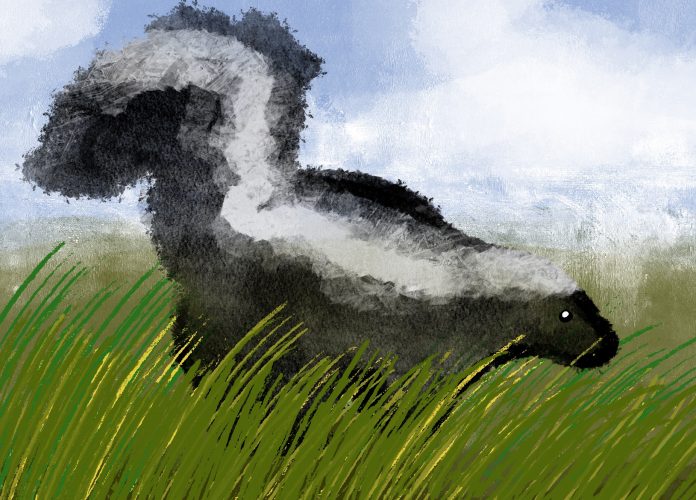Tom Cordero
Contributing Writer
If you have ever taken an evening walk through the UC Santa Barbara (UCSB) campus or along its nearby trails, you have likely had a close encounter with the striped skunk. These critters are known, and often feared, for their odorous self-defense mechanism, in which they expel musk from scent glands under their tails. Despite this reputation, these skunks are a valuable (and adorable) part of our local ecosystem.
The striped skunk is a cat-sized mammal that sports two white stripes along its back and a large, bushy tail. As a nocturnal species, this skunk sleeps throughout the day and forages at night. During the day, striped skunks find refuge in abandoned dens, hollowed logs, and brush piles. In Isla Vista (I.V.), these skunks can often be found residing in bushes or rummaging through trash cans at night.
Like other skunk species, the striped skunk is omnivorous, spending the spring and summer digging for insects and feasting on fallen fruits from trees. During the winter, these skunks shift to a more carnivorous diet, eating rodents, lizards, worms, snails, and a variety of other small animals. Although striped skunks do not hibernate, they experience long periods of inactivity during the winter. As a result, they often lose up to 50 percent of their body mass during the colder months of the year, before returning to their original size upon the arrival of warmer weather.
Like many other animal species in California, striped skunks face a variety of environmental threats. Among these threats is the presence of automobiles near-native skunk habitats. Although wild skunks have an average lifespan of seven years, juveniles are often struck and killed by cars within the first year of their lives. Striped skunks also face the threat of hunting and trapping, although the killing of skunks for their fur has decreased within the last century as a result of changes in fashion.
The relationship between striped skunks and humans is often marked by hostility. Due to the skunks’ reputation as rabid scavengers, they are often treated as pests, with many urban skunks being captured or exterminated by local authorities. In Santa Barbara, animal control agencies such as So-Cal Pest Control specialize in the removal of skunks from their urban habitat, citing their “terrible smell” and susceptibility to spreading harmful diseases. Wild striped skunks living near campsites are frequently euthanized when they approach humans in search of food, which typically occurs as the result of campers feeding them against campsite regulations.
However, despite the various threats that striped skunks face, their conservation status is listed as “Least Concern” by the International Union for Conservation of Nature. This is due in large part to the species’ ability to thrive in a wide variety of habitats, assisted by their highly versatile diet. Striped skunks enjoy a stable and continuous population across North America, residing in forests, savannas, grasslands, and even cities.
Considering the wide variety of plant and animal life around UCSB, it is easy to overlook the striped skunk in favor of flashier and more visible species. However, even this seemingly unremarkable critter is an essential part of the health and beauty of our local environment.











